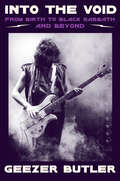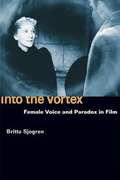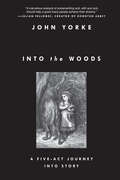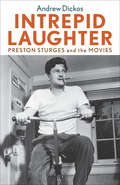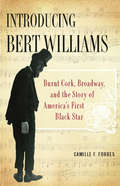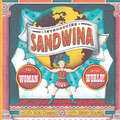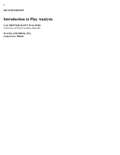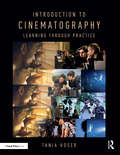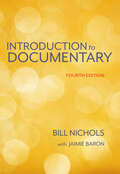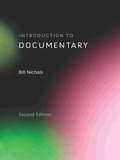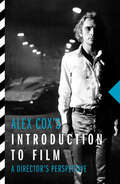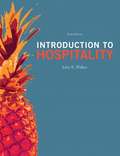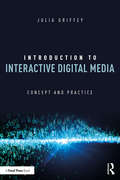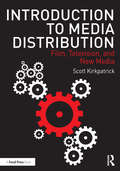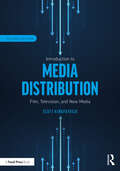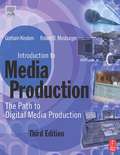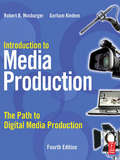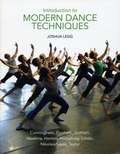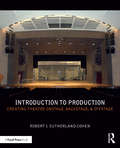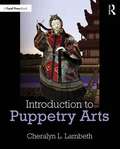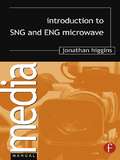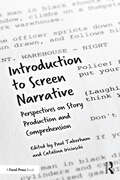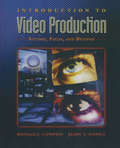- Table View
- List View
Into the Void: From Birth to Black Sabbath—And Beyond
by Geezer ButlerA rollicking, effusive, and candid memoir by the heavy metal musician and founding member of Black Sabbath, covering his years as the band’s bassist and main lyricist through his later-career projects, and detailing how one of rock’s most influential bands formed and prevailed. With over 70 million records sold, Black Sabbath, dubbed by Rolling Stone “the Beatles of heavy metal,” helped create the genre itself, with their distinctive heavy riffs, tuned down guitars, and apocalyptic lyrics. Bassist and primary lyricist Geezer Butler played a gigantic part in the band’s renown, from suggesting the band name to using his fascination with horror, religion, and the occult to compose the lyrics and build the foundation of heavy metal as we know it.In Into the Void, Butler tells his side of the story, from the band’s beginnings as a scrappy blues quartet in Birmingham through the struggles leading to the many well-documented lineup changes while touring around London’s gritty clubs (Eric Clapton, Jimi Hendrix, Frank Zappa, and The Who makes notable appearances!), and the band’s important later years. He writes honestly of his childhood in a working-class family of seven in Luftwaffe-battered Birmingham, his almost-life as an accountant, and how his disillusionment with organized religion and class systems would spawn the lyrics and artistic themes that would resonate so powerfully with fans around the world.Into the Void reveals the softer side of the heavy metal legend and the formation of one of rock’s most exciting bands, while holding nothing back. Like Geezer’s bass lines, it is both original, dramatic, and forever surprising.
Into the Vortex: Female Voice and Paradox in Film
by Britta H. SjogrenInto the Vortex challenges and rethinks feminist film theory's brilliant but often pessimistic reflections on the workings of sound and voice in film. Including close readings of major film theorists such as Kaja Silverman and Mary Ann Doane, Britta H. Sjogren offers an alternative to image-centered scenarios that dominate feminist film theory's critique of the representation of sexual difference. Sjogren focuses on a rash of 1940s Hollywood films in which the female voice bears a marked formal presence to demonstrate the ways that the feminine is expressed and difference is sustained. She argues that these films capitalize on particular particular psychoanalytic, narratological and discursive contradictions to bring out and express difference, rather than to contain or close it down. Exploring the vigorous dynamic engendered by contradiction and paradox, Sjogren charts a way out of the pessimistic, monolithic view of patriarchy and cinema's representation of women's voices.
Into the Woods: A Five-Act Journey Into Story
by John YorkeAn analysis of the fundamental narrative structure, why it works, the meanings of stories, and why we tell them in the first place.The idea of Into the Woods is not to supplant works by Aristotle, Lajos Egri, Robert McKee, David Mamet, or any other writers of guides for screenwriters and playwrights, but to pick up on their cues and take the reader on a historical, philosophical, scientific, and psychological journey to the heart of all storytelling. In this exciting and wholly original book, John Yorke not only shows that there is truly a unifying shape to narrative—one that echoes the great fairytale journey into the woods, and one, like any great art, that comes from deep within—he explains why, too. With examples ranging from The Godfather to True Detective, Mad Men to Macbeth, and fairy tales to Forbrydelsen (The Killing), Yorke utilizes Shakespearean five-act structure as a key to analyzing all storytelling in all narrative forms, from film and television to theatre and novel-writing—a big step from the usual three-act approach. Into the Woods: A Five-Act Journey into Story is destined to sit alongside David Mamet’s Three Uses of the Knife, Robert McKee’s Story, Syd Field’s Screenplay, and Lajos Egri’s The Art of Dramatic Writing as one of the most original, useful, and inspiring books ever on dramatic writing.Praise for Into the Woods“Love storytelling? You need this inspiring book. John Yorke dissects the structure of stories with a joyous enthusiasm allied to precise, encyclopedic knowledge. Guaranteed to send you back to your writing desk with newfound excitement and drive.” —Chris Chibnall, creator/writer, Broadchurch and Gracepoint“Outrageously good and by far and away the best book of its kind I’ve ever read. I recognized so much truth in it. But more than that, I learned a great deal. Time and again, Yorke articulates things I’ve always felt but have never been able to describe. . . . This is a love story to story—erudite, witty and full of practical magic. I struggle to think of the writer who wouldn’t benefit from reading it—even if they don’t notice because they’re too busy enjoying every page.” —Neil Cross, creator/writer, Luther and Crossbones“Part ‘how-to’ manual, part ‘why-to’ celebration, Into the Woods is a wide-reaching and infectiously passionate exploration of storytelling in all its guises . . . exciting and thought-provoking.” —Emma Frost, screenwriter, The White Queen and Shameless
Intrepid Laughter: Preston Sturges and the Movies (Screen Classics)
by Andrew DickosThe life and career of the pioneering writer-director whose name is synonymous with sophisticated screwball comedies.Preston Sturges was known for bringing sophistication and wit to the genre of comedy, establishing himself as one of the most valuable writer-directors in 1940s Hollywood. Today, more than a half century after they were originally produced, his films have lost little of their edge and remain extremely popular.Intrepid Laughter is an essential guide to the life and work of this luminary of the stage and screen, following Sturges from his unusual childhood, to his early success as a Broadway playwright, to his whirlwind career in Hollywood.
Introducing Bert Williams: Burnt Cork, Broadway, and the Story of America's First Black Star
by Camille F. ForbesAccording to critics of his time, Bert Williams was "the Greatest Comedian on the American Stage." A black Bahamian immigrant, Williams made his start as a barker advertising the rough-and-tumble "medicine shows" that dotted the Wild West at the end of the nineteenth century. Not long after joining a minstrel troupe and donning the burnt- cork makeup of blackface, he teamed up with African American George Walker in a sixteen-year partnership that would take them from rural western mining towns to the bright lights of Broadway.In Introducing Bert Williams, historian Camille Forbes reveals a fascinating figure, initiating the reader into the vivid world of nineteenth- and early twentieth-century popular entertainment. Williams's long and varied career is a whirlwind of drama, glamour, and ambition-nothing less than the birth of American show business.
Introducing Sandwina: The Strongest Woman in the World!
by Vicki ConradNo one believed a woman could be stronger than a man, until Katie Brumbach–also known as Sandwina—displayed her show-stopping feats as a circus strongwoman.100 pounds . . . 200 pounds . . . 300 pounds! Katie Brumbach became the world&’s top strongwoman after she ousted Eugen Sandow by lifting hundreds of pounds over her head (which Sandow could barely lift to his shoulders). After that, she took the last name Sandwina and thrived in the circus world—which she had been participating in since the age of two when she first performed with her family. She grew over six feet tall as she got older, but Katie never second-guessed herself, and she trained to build her muscles, always eager to test her skills and try new feats. After starting a family with a fellow performer, they were eventually signed to work with John Ringling of the Ringling Bros. Circus. Sandwina impressed the crowds by balancing a 1,000-pound cannon on her chest, by throwing a one-ton stone, and by having an iron slab broken on her body—she stole the show!
Introduction To Play Analysis
by Scott E. Walters Cal PritnerIn this indispensable companion to any theatre class in which scripts are read and interpreted, Pritner and Walters offer five sequential levels of reading designed to lead to a deep understanding of the text. Level one imagines the play as performed in front of an audience; level two examines the deep structure of the conflict; level three examines given circumstances and the type of relationship the play creates between the audience and the production; level four looks closely at characters' behavior and reactions to their given circumstances, surveys conflict in each scene, and encourages supplemental research about the play; finally, level five synthesizes the information acquired from the preceding levels.
Introduction to Cinematography: Learning Through Practice
by Tania Hoser<p>Introduction to Cinematography offers a practical, stage-by-stage guide to the creative and technical foundations of cinematography. Building from a skills-based approach focused on professional practice, author Tania Hoser provides a step-by-step introduction for both cinematographers and camera assistants to the techniques, processes, and procedures of working with cameras, lenses, and light. She provides hands-on insight on negotiating with production constraints and understanding the essentials of the image workflow from shot to distribution, on projects of any scope and budget. <p>Richly illustrated, the book incorporates exercises and sample scripts throughout, exploring color, speed, movement ‘blocking’ and pacing scenes. As with all areas, the principles and techniques of shaping and controlling light are applied to working with natural light, film lamps, and low budget alternatives. This makes Introduction to Cinematography the perfect newcomer’s guide to learning the skills of cinematography that enables seamless progression from exercises through to full feature shoots. Assessment rubrics provide a framework to measure progress as the reader’s ability to visually interpret scripts and realize the director’s vision develops.</p>
Introduction to Documentary, Fourth Edition
by Bill Nichols Jaimie BaronThe fourth edition of Bill Nichols's best-selling text, Introduction to Documentary, has been vastly altered in its entirety to bring this indispensable textbook up to date and reconceptualize aspects of its treatment of documentaries past and present. Here Nichols, with Jaimie Baron, has edited each chapter for clarity and ease of use and expanded the book with updates and new ideas.Featuring abundant examples and images, Introduction to Documentary, Fourth Edition is designed to facilitate a rich understanding of how cinema can be used to document the historical world as it is seen by a wide variety of filmmakers. Subjectivity, expressivity, persuasiveness, and credibility are crucial factors that move documentary film away from objective documentation and toward the thought-provoking realm of arguments, perceptions, and perspectives that draw from a filmmaker's unique sensibility to help us see the world as we have not seen it before. Exploring ethics, history, different modes of documentary, key social issues addressed, and both the origins and evolution of this form, this updated volume also offers guidance on how to write about documentaries and how to begin the process of making one. Introduction to Documentary, Fourth Edition will be of use not only to film students but also those in adjacent fields where visual representations of reality play an important role: journalism, sociology, anthropology, feminist and ethnic studies, among others.
Introduction to Documentary, Second Edition
by Bill NicholsThis new edition of Bill Nichols's bestselling text provides an up-to-date introduction to the most important issues in documentary history and criticism. Designed for students in any field that makes use of visual evidence and persuasive strategies, Introduction to Documentary identifies the distinguishing qualities of documentary and teaches the viewer how to read documentary film. Each chapter takes up a discrete question, from "How did documentary filmmaking get started?" to "Why are ethical issues central to documentary filmmaking?" Carefully revised to take account of new work and trends, this volume includes information on more than 100 documentaries released since the first edition, an expanded treatment of the six documentary modes, new still images, and a greatly expanded list of distributors.
Introduction to Documentary, Third Edition
by Bill NicholsThe third edition of Bill Nichols’s best-selling text provides an up-to-date introduction to the most important issues in documentary history and criticism. Designed for students in any field that makes use of visual evidence and persuasive strategies, Introduction to Documentary identifies the genre’s distinguishing qualities and teaches the viewer how to read documentary film. Each chapter takes up a discrete question, from "How did documentary filmmaking get started?" to "Why are ethical issues central to documentary filmmaking?" Here Nichols has fully rewritten each chapter for greater clarity and ease of use, including revised discussions of earlier films and new commentary on dozens of recent films from The Cove to The Act of Killing and from Gasland to Restrepo. A new chapter, "I Want to Make a Documentary: Where Do I Start?" guides readers through the steps of planning and preproduction and includes an example of a project proposal for a film that went on to win awards at major festivals.
Introduction to Film Studies, 5th edition: An Introduction To Film Studies
by Bill Nichols Jill NelmesIntroduction to Film Studies is a comprehensive textbook for students of cinema. This completely revised and updated fifth edition guides students through the key issues and concepts in film studies, traces the historical development of film and introduces some of the worlds key national cinemas. A range of theories and theorists are presented from Formalism to Feminism, from Eisenstein to Deleuze. Each chapter is written by a subject specialist, including two new authors for the fifth edition. A wide range of films are analysed and discussed. It is lavishly illustrated with 150 film stills and production shots, in full colour throughout. Reviewed widely by teachers in the field and with a foreword by Bill Nichols, it will be essential reading for any introductory student of film and media studies or the visual arts worldwide. Key features of the fifth edition are: updated coverage of a wide range of concepts, theories and issues in film studies in-depth discussion of the contemporary film industry and technological changes new chapters on Film and Technology and Latin American Cinema new case studies on films such as District 9, Grizzly Man, Amores Perros, Avatar, Made in Dagenham and many others marginal key terms, notes, cross-referencing suggestions for further reading, further viewing and a comprehensive glossary and bibliography a new, improved companion website including popular case studies and chapters from previous editions (including chapters on German Cinema and The French New Wave), links to supporting sites, clips, questions and useful resources. Individual chapters include: The Industrial Contexts of Film Production · Film and Technology · Getting to the Bigger · Picture Film Form and Narrative · Spectator, Audience and Response · Cinematic authorship and the film auteur · Stardom and Hollywood Cinema · Genre, Theory and Hollywood Cinema The Documentary Form · The Language of Animation · Gender and Film · Lesbian and Gay Cinema · Spectacle, Stereotypes and Films of the African Diaspora · British Cinema · Indian Cinema · Latin American Cinema · Soviet Montage Cinema of the 1920s Contributors: Linda Craig, Lalitha Gopalan, Terri Francis, Chris Jones, Mark Joyce, Searle Kochberg, Lawrence Napper, Jill Nelmes, Patrick Phillips, Suzanne Speidel, Paul Ward, Paul Watson, Paul Wells and William Wittington
Introduction to Film: A Director's Perspective
by Alex Cox’sEmerging filmmakers need to know the basics of their art form: the language of the camera, and lenses, the different crew roles, the formats, the aspect ratios. They also need to know some bare-bones theory: what an auteur is, what montage is, what genres are. But, even more urgently, young filmmakers need answers to their questions—What lens was used? How did they do that effect? Who paid for that picture? How did they get it past the censor? Most important, Alex Cox believes that all filmmakers require serious grounding in film. You cannot be a great artist if you aren't versed in great art. And this doesn't just apply to the cinema. This book is for aspiring filmmakers, but also for students, and for people generally interested in grounding themselves in this particular art form—from a filmmaker's perspective. According to Coz, "I believe 100% that a reasonably educated and intelligent person in any country of the world should be able to have a conversation about Luis Buñuel, about Akira Kurosawa, about Stanley Kubrick, about Fellini or Bergman, and talk knowledgeably about at least one of their films. Read this book, watch the films, and you can!"
Introduction to Hospitality (6th edition)
by John R. WalkerThe Sixth Edition of Introduction to Hospitality focuses on hospitality operations while offering a broad, comprehensive foundation of current knowledge about the world's largest industry. The text is organized into five sections: the hospitality industry and tourism; lodging; restaurants, managed services, and beverages; recreation, theme parks, clubs, and gaming entertainment; and assemblies and event management.
Introduction to Interactive Digital Media: Concept and Practice
by Julia V. GriffeyThis book offers a clearly written and engaging introduction to the basics of interactive digital media. As our reliance on and daily usage of websites, mobile apps, kiosks, games, VR/AR and devices that respond to our commands has increased, the need for practitioners who understand these technologies is growing. Author Julia Griffey provides a valuable guide to the fundamentals of this field, offering best practices and common pitfalls throughout. The book also notes opportunities within the field of interactive digital media for professionals with different types of skills, and interviews with experienced practitioners offer practical wisdom for readers. Additional features of this book include: An overview of the history, evolution and impact of interactive media; A spotlight on the development process and contributing team members; Analysis of the components of interactive digital media and their design function (graphics, animation, audio, video, typography, color); An introduction to coding languages for interactive media; and A guide to usability in interactive media. Introduction to Interactive Digital Media will help both students and professionals understand the varied creative, technical, and collaborative skills needed in this exciting and emerging field.
Introduction to Media Distribution: Film, Television, and New Media
by Scott KirkpatrickIntroduction to Media Distribution offers a clear, direct and comprehensive overview of the entire film, television and new media distribution business, valuable to both students and professionals. In this book, author Scott Kirkpatrick draws from over a decade of personal experience in the distribution arena to explore what fuels the distribution process, and explains in real-world terms how the business works from beginning to end—not merely what happens to a film or television series after a distributor acquires it, but how distributors develop, pre-sell and broker deals on content before it even exists. Kirkpatrick covers deal structures, release strategies, acquisition approaches, rights sales, international co-productions, tax credits, audience research, global regulatory boards, and even ‘behind closed doors’ monetization practices. The book offers: A straightforward, clear and insightful approach to understanding the fundamental basics of how the global distribution marketplace works, and how distribution companies actually operate and create the content they need; An insider’s analysis of all levels of the business with an emphasis on the independent scene, the root from where development in the industry grows; A comprehensive overview of how film and television markets and festivals work, and how buyers and sellers actually broker deals in the field; Detailed explanations of how each media right is defined and windowed to maximize potential revenue; A detailed overview of several major international territories, and how each operates within the context of the global media business; Guidance and advice from an industry expert on how one can initiate their professional career in the entertainment industry, applicable to individuals in all roles; A robust appendix containing in-depth studies of legal definitions, material delivery requirements, territory-by-territory financial projections, and more. An accompanying eResource offers template contracts, sample agreements, and further resources for download.
Introduction to Media Distribution: Film, Television, and New Media
by Scott KirkpatrickIn this second edition, author Scott Kirkpatrick draws from over a decade of personal experience in the distribution arena to provide a clear and up-to-date overview of the entire film, television, and new media distribution business. Readers will learn what fuels the distribution process and exactly how the distribution business works from beginning to end—not merely what happens to a film or television series upon acquisition, but how distributors develop, presell and broker deals on content before it even exists. This new edition considers a much more international approach to media distribution, with case studies and analyses from across the globe. It also reflects on the ever-increasing relevance of diversity and inclusiveness in the industry, as well as the new media verticals like podcasts and the effects of social media influencers on the media landscape. The book will be an integral guidebook for any student or professional wishing to understand both the basics and the subtleties of media distribution. The book also contains a robust appendix containing in-depth studies of legal definitions, material delivery requirements, territory-by-territory financial projections and more.
Introduction to Media Production: The Path to Digital Media Production
by Gorham Kindem Robert B. MusburgerIntroduction to Media Production, Third Edition, provides students with a practical framework for all aspects of media production by addressing the technological and aesthetic changes that have shaped the industry. Offering both hands-on instruction and theoretical information, it provides a sound basis for the techniques, operations, and philosophies of media production in the new digital environment.The new edition has been updated throughout with detailed information on how digital processes have changed everything from shooting to editing to finishing. It includes content on the Internet, writing for the Internet, Graphics and Animation.
Introduction to Media Production: The Path to Digital Media Production
by Gorham Kindem Robert B. MusburgerIntroduction to Media Production began years ago as an alternative text that would cover ALL aspects of media production, not just film or just tv or just radio. Kindem and Musburger needed a book that would show students how every form of media intersects with one another, and about how one needs to know the background history of how film affects video, and how video affects working in a studio, and ultimately, how one needs to know how to put it all together. Introduction to Media Production is the book that shows this intersection among the many forms of media, and how students can use this intersection to begin to develop their own high quality work.Introduction to Media Production is a primary source for students of media. Its readers learn about various forms of media, how to make the best use of them, why one would choose one form of media over another, and finally, about all of the techniques used to create a media project. The digital revolution has exploded all the former techniques used in digital media production, and this book covers the now restructured and formalized digital workflows that make all production processes by necessity, digital. This text will concentrate on offering students and newcomers to the field the means to become aware of the critical importance of understanding the end destination of their production as a part of pre-production, not the last portion of post production.Covering film, tv, video, audio, and graphics, the fourth edition of Introduction to Digital Media promises to be yet another comprehensive guide for both students of media and newcomers to the media industry.
Introduction to Modern Dance Techniques
by Joshua LeggBringing together all of the major modern dance techniques from the last 80 years, this engaging account is the first of its kind. The informative discussion starts by mapping the historical development of modern dance: in the late 19th century, a new dance emerged--not yet known as modern dance--that rejected social strictures and ballet as well. With insight into the personalities and purposes of modern dance's vanguard--including Martha Graham, Lester Horton, José Limón, and Merce Cunningham--this compilation provides a comparative approach that will enable students to discern which technique best suits them and dispel the idea that there is a single, universal modern dance technique. There are also ideas for experimentation so that students can begin developing an aesthetic sense for not only what is pleasing to their artistic eye, but also for what technical ideas are exciting while their own body is in motion. Sample lessons are included for teachers to incorporate the text into courses.
Introduction to Production: Creating Theatre Onstage, Backstage, & Offstage
by Robert I. Sutherland-CohenIntroduction to Production: Creating Theatre Onstage, Backstage, & Offstage defines the collaborative art of making theatre and the various job positions that go into realizing a production. Beginning with an overview of the art and industry of theatre, the book shows how theatre has evolved through history. The book then breaks down the nuts and bolts of the industry by looking at each professional role within it: from the topmost position of the producer down to the gopher, or production assistant. Each of these positions are defined along with their respective duties, rules, and resources that figure in obtaining these jobs. Each chapter offers exercises, links to videos and websites, review quizzes, and suggested readings to learn more about the creation and production of theatre.
Introduction to Puppetry Arts
by Cheralyn LambethIntroduction to Puppetry Arts shares the history, cultures, and traditions surrounding the ancient performance art of puppetry, along with an overview of puppet construction and performance techniques used around the world. From its earliest beginnings in the ancient Middle East and Asia, through its representations in Medieval/Renaissance Europe, up until its modern-day appearances in theatre, television, and film, this book offers a thorough overview of how this fascinating art form originated and evolved. It also includes easy-to-follow instructions on how to create puppets for performance and display and an in-depth resource list and bibliography for further research and information. Written for students in puppetry arts and stagecraft courses, Introduction to Puppetry Arts offers a comprehensive look at this enduring craft and provides a starting point for creating a wide range of puppets, from marionettes and hand puppets to mascots and character costumes.
Introduction to SNG and ENG Microwave
by Jonathan HigginsAn excellent primer on the subject, this book gives beginning professionals in satellite newsgathering an introduction to the technologies and processes involved. It will also suit journalists, editors and producers needing to understand this important element of the newsgathering chain. Written for the complete beginner, the book shows how typical transmission chains work and their communication with the studio. It also offers a brief introduction to analogue and digital theory before going onto to explain Electronic Newsgathering (ENG) systems: from basic principles: transmission and reception chains, frequencies used and why, through to audio channel, subcarriers and digital modulation, as well as applications: radio cameras, window links, infra-red & laser links.A brief chapter on satellite theory gives an overview of satellite communication and orbits, basic satellite communication theory, transportables (`flyaways') and trucks, as well as analogue vs digital issues, digital compression and MPEG. Systems regulations and operations are also introduced as well as safety and logistics issues.If you're looking for a quick and easy introduction to the subject, this book will act as an essential on the job reference guide.
Introduction to Screen Narrative: Perspectives on Story Production and Comprehension
by Paul Taberham Catalina IricinschiBringing together the expertise of world-leading screenwriters and scholars, this book offers a comprehensive overview of how screen narratives work. Exploring a variety of mediums including feature films, television, animation, and video games, the volume provides a contextual overview of the form and applies this to the practice of screenwriting. Featuring over 20 contributions, the volume surveys the art of screen narrative, and allows students and screenwriters to draw on crucial insights to further improve their screenwriting craft. Editors Paul Taberham and Catalina Iricinschi have curated a volume that spans a range of disciplines including screenwriting, film theory, philosophy and psychology with experience and expertise in storytelling, modern blockbusters, puzzle films and art cinema. Screenwriters interviewed include: Josh Weinstein (The Simpsons, Gravity Falls), David Greenberg (Stomping Ground, Used to Love Her), Evan Skolnick and Ioana Uricaru. Ideal for students of Screenwriting and Screen Narrative as well as aspiring screenwriters wanting to provide theoretical context to their craft.
Introduction to Video Production: Studio, Field, and Beyond
by Ronald Compesi Jaime GomezWritten in a clear, non-technical manner, Introduction to Video Production focuses on the fundamental principles of video production and the technologies used in production. This book discusses video aesthetics, technologies, and production practice in a clear and concise manner. It also emphasizes the importance of teamwork and planning in the production process. Chapters are clearly organized and heavily illustrated, with key terms identified in boldface. With Introduction to Video Production, readers will learn not only how the technology works, but how to work with the technology and with each other.
